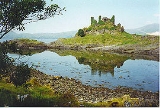
Coeffin
Encyclopedia
aug1995.jpg)
Lismore, Scotland
Lismore is a partially Gaelic speaking island in the Inner Hebrides of Scotland. This fertile, low-lying island was once a major centre of Celtic Christianity, with a monastery founded by Saint Moluag and the seat of the Bishop of Argyll.-Geography:...
, an island in Loch Linnhe
Loch Linnhe
Loch Linnhe is a sea loch on the west coast of Scotland....
, in Argyll
Argyll
Argyll , archaically Argyle , is a region of western Scotland corresponding with most of the part of ancient Dál Riata that was located on the island of Great Britain, and in a historical context can be used to mean the entire western coast between the Mull of Kintyre and Cape Wrath...
, on the west coast of Scotland
Scotland
Scotland is a country that is part of the United Kingdom. Occupying the northern third of the island of Great Britain, it shares a border with England to the south and is bounded by the North Sea to the east, the Atlantic Ocean to the north and west, and the North Channel and Irish Sea to the...
. It stands on a promontory on the north-west coast of the island, across Loch Linnhe from Glensanda
Glensanda
Glensanda was a Viking settlement at the mouth of Glen Sanda on the Morvern peninsula within south west Lochaber, overlooking the Isle of Lismore and Loch Linnhe in the western Highlands of Scotland....
, at .
History
Coeffin Castle was built on the site of a VikingViking
The term Viking is customarily used to refer to the Norse explorers, warriors, merchants, and pirates who raided, traded, explored and settled in wide areas of Europe, Asia and the North Atlantic islands from the late 8th to the mid-11th century.These Norsemen used their famed longships to...
fortress. The name Coeffin is thought to come from Caifen who was a Viking prince, and whose sister supposedly haunted the castle until her remains were taken back to be buried beside her lover in Norway
Norway
Norway , officially the Kingdom of Norway, is a Nordic unitary constitutional monarchy whose territory comprises the western portion of the Scandinavian Peninsula, Jan Mayen, and the Arctic archipelago of Svalbard and Bouvet Island. Norway has a total area of and a population of about 4.9 million...
.
Coeffin Castle was built in the 13th century, probably by the MacDougall
Clan MacDougall
Clan MacDougall is a Highland Scottish clan consisting of the descendants of Dubgall mac Somairle, son of Somerled, who ruled Lorne and the Isle of Mull in Argyll in the 13th century...
s of Lorn. Lismore was an important site within their lordship, being the location of St. Moluag's Cathedral, seat of the Bishop of Argyll
Bishop of Argyll
The Bishop of Argyll or Bishop of Lismore was the ecclesiastical head of the Diocese of Argyll, one of Scotland's 13 medieval bishoprics. It was created in 1200, when the western half of the territory of the Bishopric of Dunkeld was formed into the new diocese. The bishops were based at Lismore...
. The first written evidence of the castle occurs in 1469–70, when it was granted to Sir Colin Campbell of Glenorchy by Colin Campbell, 1st Earl of Argyll
Colin Campbell, 1st Earl of Argyll
Colin Campbell, 1st Earl of Argyll was a Scottish nobleman.-Biography:He was the son of Gillespic Campbell, Master of Campbell and Elizabeth Somerville. Elizabeth Somerville was the daughter of John Somerville, 3rd Lord Somerville and Helen Hepburn...
. It is unlikely to have been occupied in post-mediaeval times.
The ruins
The ruins comprise an oblong hall-house and an irregularly shaped bailey. The hall is an irregular rectangle, measuring 20.3 by The walls are from 2.1 to 2.4 m (6.9 to 7.9 ) thick. The bailey was mostly built at a later date than the hall. An external stair probably linked the entrance, in the north-east wall, to the bailey. A second door gave access to the sea to the south-west.Other features
A tidal fish trapFishing weir
A fishing weir, or fish weir, is an obstruction placed in tidal waters or wholly or partially across a river, which is designed to hinder the passage of fish. Traditionally they were built from wood or stones. They can be used to trap fish...
, of unknown age, is located in the small bay to the south-east of the castle. To the north-east of the castle are the remains of a stone-walled fort. The Ordnance Gazetteer of Scotland, published in 1892, lists a Castle Rachal in the same general location as Castle Coeffin. It is described as "a very ancient Scandinavian fortalice in Lismore and Appin parish, Argyllshire, on the NW side of Lismore island, 2.5 miles from the north-eastern extremity, now a dilapidated ivy-clad ruin."

